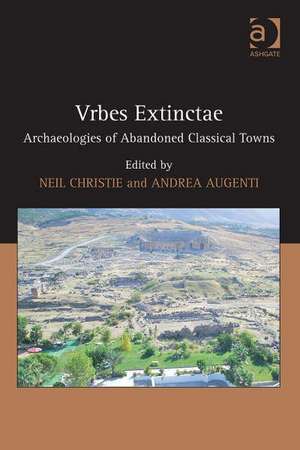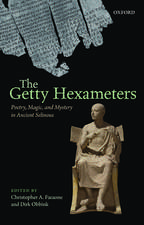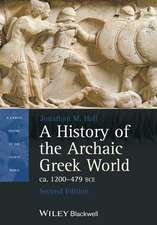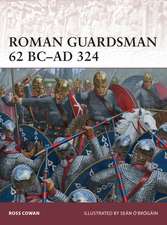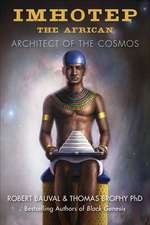Vrbes Extinctae: Archaeologies of Abandoned Classical Towns
Autor Andrea Augenti Editat de Neil Christieen Limba Engleză Hardback – 5 dec 2012
| Toate formatele și edițiile | Preț | Express |
|---|---|---|
| Paperback (1) | 259.98 lei 6-8 săpt. | |
| Taylor & Francis – 30 iun 2020 | 259.98 lei 6-8 săpt. | |
| Hardback (1) | 652.30 lei 3-5 săpt. | |
| Taylor & Francis – 5 dec 2012 | 652.30 lei 3-5 săpt. |
Preț: 652.30 lei
Preț vechi: 1146.67 lei
-43% Nou
Puncte Express: 978
Preț estimativ în valută:
124.81€ • 130.32$ • 103.30£
124.81€ • 130.32$ • 103.30£
Carte disponibilă
Livrare economică 14-28 martie
Preluare comenzi: 021 569.72.76
Specificații
ISBN-13: 9780754665625
ISBN-10: 0754665623
Pagini: 424
Dimensiuni: 156 x 234 mm
Greutate: 1.04 kg
Ediția:New.
Editura: Taylor & Francis
Colecția Routledge
Locul publicării:Oxford, United Kingdom
ISBN-10: 0754665623
Pagini: 424
Dimensiuni: 156 x 234 mm
Greutate: 1.04 kg
Ediția:New.
Editura: Taylor & Francis
Colecția Routledge
Locul publicării:Oxford, United Kingdom
Cuprins
Contents: Preface; Vrbes extinctae: archaeologies of and approaches to abandoned classical cities Neil Christie; Classe: archaeologies of a lost city, Andrea Augenti; Potentia: a lost new town, Frank M.R. Vermeulen; After the rats: Cosa in the late Empire and early Middle Ages, Enrico Cirelli and Elizabeth Fentress; Urban change on the Balearics in late Antiquity, Miguel Ãngel Cau; Recopolis: Vrbs Relicta? An historico-archaeological debate, Isabel Velázquez and Gisella Ripoll; Deciphering 'lost' urban landscapes at Cyrene, Gareth Sears, Vince Gaffney, Chris Gaffney, Richard Cuttler, Helen Goodchild and Susan Kane; An 'Ice Age settling on the Roman Empire': post-Roman Butrint between strategy and serendipity, William Bowden and Richard Hodges; Memory and loss in the late antique cities of Knossos and Sparta, Rebecca J. Sweetman; Hierapolis of Phrygia: the drawn-out demise of an Anatolian city, Paul Arthur; Dura deserta: the death and afterlife of Dura-Europos, J.A. Baird; Calleva Atrebatum (Silchester, Hampshire, UK): an early medieval extinction, Michael Fulford; Concluding remarks: a tale of many (lost) cities: past, present and future, Andrea Augenti; Index.
Notă biografică
Neil Christie is Reader in Archaeology at the University of Leicester, UK and Andrea Augenti is Professor of Archaeology at the University of Bologna - Ravenna Campus, Italy.
Recenzii
'In sum, a well-produced and thought-provoking volume; I particularly liked the neat solution used to integrate the colour plates, reproduced separately, into their respective articles using black and white thumbnail images in the text.' Antiquity 'This volume joins an extensive and still-growing body of literature on classical and Late Antique urbanism, as well as considerations of "decline and fall' within the later Roman empire. It breaks significant new ground by combining these two areas of research within a single volume and by developing and maintaining a strong theme of new ideas related to the challenges and potential of archaeological research focused on the development, abandonment, and later activities of former urban centers. ... a must-buy...' American Journal of Archaeology ’Il volume [...] rappresenta un contributo prezioso... I risultati delle ricerche e le nuove conoscenze portate alla luce in questo volume, con le figure di alta qualità , rappresentano un apprezzabile passo avanti... ’ [’This volume represents an important contribution... The results of this research and the new knowledge brought to light in this volume, with high quality images, represent a great stride forward...’] Hortus Artium Medievalium (HAM) 'This valuable book lets the archaeology ’talk’ far more in showing the changes, losses and transformations to a variety of late Roman cities and in revealing their medieval successors.' Medieval Archaeology ’... breaks significant new ground ... by developing and maintaining a strong theme of new ideas related to the challenges and potential of archaeological research focused on the development, abandonment, and later activities of former urban centers. The included case studies offer something for specialists and students of nearly every region of classical and Late Antique archaeology ... it is a must-buy for academic libraries ... The volume offers much for students and scholars within classics, ancient history,
Descriere
The essays in this collection consider specific examples and case studies of 'lost' classical cities from across the many Roman provinces in order to help understand why some 'failed' and were subsequently abandoned. Bringing together both established and rising international scholars to share views on and findings from excavations and surveys of 'failed' towns, this volume has much to offer scholars of Roman, late antique and early medieval archaeology, urban scholars and ancient historians.
